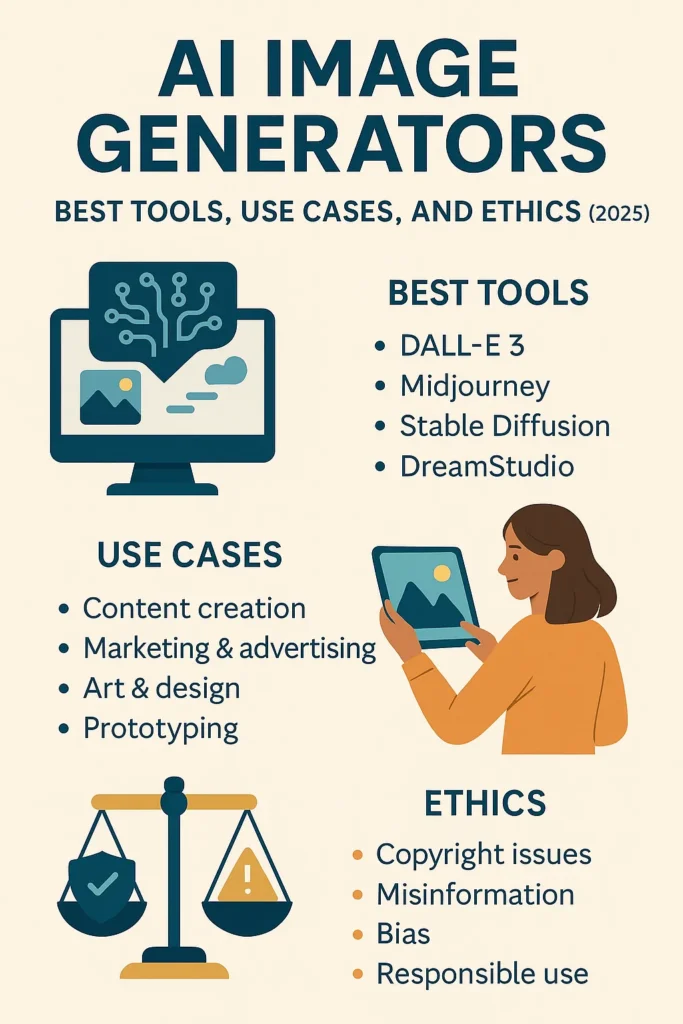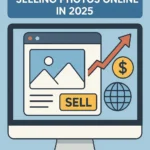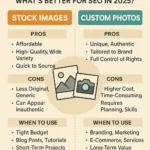
AI Image Generators in 2025: Tools I Use, What They’re Good For, and What to Watch Out For
It’s wild how much image creation has changed in just a few years. Back in the day, if you needed visuals for your blog, brand, or business, you either had to be a designer or hire one. Now? You can describe what you want in a sentence, and an AI will create it in seconds.
I’ve been using AI image generators regularly throughout 2024 and into 2025—both for blog graphics and client projects—and I’ve learned a few things. Some tools are amazing. Some are hit or miss. And as with anything AI-related, there are a few ethical lines you really don’t want to cross.
Here’s what I’ve learned (and what I think you should know) if you’re using or planning to use AI-generated images in your work.
What Exactly Is an AI Image Generator?
In simple terms, it’s a tool that turns words into images.
You type something like “a cozy reading nook with warm lights and a cat on the windowsill,” and the AI turns that into a realistic-looking (or artistic) picture. Most of these tools are powered by deep learning models like GANs (Generative Adversarial Networks) or diffusion models, which are trained on millions (sometimes billions) of images.
You don’t need to understand the tech. What matters is that it works—and the better your prompt, the better your result.
My Go-To AI Image Tools in 2025
Here are the ones I’ve tried and what I actually use them for:
1. DALL·E 4 (by OpenAI)
This is my default when I want clean, realistic images—especially for blog thumbnails or professional graphics. The inpainting feature (editing specific parts of an image) is a lifesaver. I’ve even used it to fix visual mistakes after generation.
2. Midjourney V7
I love this one for moody or artistic visuals. If I’m designing something that needs a “wow” factor—like a surreal travel scene or a fantasy-style portrait—Midjourney nails it. The stylization is strong, which can be a plus or minus depending on the project.
3. Adobe Firefly
If you already use Photoshop or Illustrator, this is gold. Firefly blends right into the workflow, especially for things like generating backgrounds or removing visual clutter. Bonus: It’s designed for commercial use, so you’re safe with AdSense and clients.
4. Leonardo AI
This one surprised me. It’s super popular in gaming and product design circles, but I’ve used it for blog infographics and mockups. It gives you more control than many others, especially if you like tweaking every detail.
5. Bing Image Creator
A good “quick and dirty” option when you just need something basic. It’s powered by DALL·E, and the results are surprisingly good for casual use. Great for simple blog visuals or social media content.
6. Dream by Wombo
It’s fun, especially if you’re experimenting with styles like anime, sci-fi, or surrealism. I’ve used it for Pinterest pins and Reels covers. Also mobile-friendly if you want to create images on the go.
Real-World Ways I Use AI Images
Here’s how I personally use AI images, and where I’ve seen others succeed with them:
- Blog Thumbnails & Hero Images – Quick to generate, fully customized, and help my posts stand out.
- Pinterest Pins – Stylized visuals perform better here, and AI makes it easy to create that look.
- Product Mockups – If you’re selling a digital product, AI can create scenes showing it in action.
- Ebooks & Lead Magnets – Instead of buying stock art, I now generate illustrations to match each section’s vibe.
- Social Media Visuals – Reels, carousels, and even inspirational quote graphics look cleaner with AI-generated backgrounds.
I also know marketers who use these tools for Facebook ads, email headers, and even pitch decks.
If You’re Using AI Images for AdSense, Read This
AdSense is strict. I’ve had sites rejected for small things—so I play it safe when using AI visuals. Here’s what I follow:
- ✅ I only use images from tools that clearly allow commercial use (like Firefly or DALL·E).
- ❌ I never generate celebrity lookalikes or brand logos—AdSense doesn’t like impersonation or copyright risk.
- ✅ I optimize all images to load fast (WebP format, compressed under 150 KB usually).
- ✅ I describe AI-generated images honestly in alt text and even mention it in my privacy policy.
If you’re applying for AdSense, I highly recommend sourcing or generating images legally and ethically. Don’t grab random ones from shady sources.
Ethical Stuff You Need to Know (and Actually Care About)
This isn’t just a buzzword—AI art comes with a few landmines:
1. Who owns the image?
Some tools (like Adobe Firefly) give you full commercial rights. Others might keep ownership or share it. Always check their terms. If you’re selling the image, licensing matters.
2. How were the tools trained?
Most AI models are trained on internet images, which includes artwork from real creators—sometimes without permission. This has sparked debates, lawsuits, and protests from artists. If you care about fairness, support platforms that are transparent about their training data.
3. Deepfake misuse
This is serious. Some people use AI to create fake images of real people—especially public figures—which can lead to misinformation or worse. Avoid anything remotely deceptive.
4. Bias in generated images
Sometimes, prompts involving race, gender, or religion produce stereotypical or weird results. It’s not your fault—it’s the AI’s training—but it’s your responsibility to check outputs and be sensitive.
5. Giving Credit (Optional but Nice)
If you’re blending AI with real photos or editing a base image you didn’t create from scratch, credit the source. It builds trust and avoids future headaches.
A Few Tips for Getting Better AI Images
This part took me the longest to figure out:
- Write Specific Prompts: Don’t just say “a woman in a kitchen.” Try: “a 30-year-old woman wearing a pastel apron, pouring coffee in a modern, sunlit kitchen – minimalist, flat style.”
- Use Adjectives and Art Styles: Include terms like “bokeh,” “digital painting,” “flat illustration,” or “cinematic lighting” to guide the tool.
- Use Inpainting and Variations: If one detail is off, don’t delete the image. Edit the part or generate variations.
- Upscale Smartly: Tools like Topaz AI or Let’s Enhance can clean up grainy AI images for bigger displays.
- Stay Consistent: If you’re branding a blog, reuse prompts or styles across images for a cohesive look.
What’s Coming Next? (And What I’m Excited About)
AI image generation isn’t slowing down. Some cool things already happening or on the horizon:
- 3D modeling from text prompts
- Instant background removal and scene swaps
- Motion graphics based on AI visuals
- Voice-to-image generation (yes, really)
Also, countries are drafting new rules. The EU is big on watermarking AI-generated content. India is working on ethical AI standards. The U.S. has some copyright laws in progress. So yeah—it’s evolving fast.
Final Thoughts
If you’re a blogger, marketer, or small business owner, AI image generators are game-changers. You don’t need to be a designer. You don’t need expensive stock subscriptions. You just need creativity, a little patience, and a tool that fits your goals.
That said—respect the process. Use these tools smartly and ethically. Don’t mislead your audience, and always prioritize quality over shortcuts.
AI won’t replace designers, but it will make visual content more accessible to everyone. That’s a huge win—if we use it right.
Now go ahead—open up your favorite tool and type in that dream scene. You might be surprised at what you can create.

